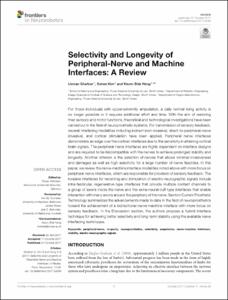Selectivity and longevity of peripheral-nerve and machine interfaces: A review
- Title
- Selectivity and longevity of peripheral-nerve and machine interfaces: A review
- Author(s)
- Ghafoor, Usman ; Kim, So Hee ; Hong, Keum-Shik
- Issued Date
- 2017-10
- Citation
- Frontiers in Neurorobotics, v.11
- Type
- Article
- Author Keywords
- Amputation ; Electro-neurographic signals ; Longevity ; Nerve-machine interfaces ; Neuroprosthetics ; Peripheral-nerve ; Selectivity ; Stability
- Keywords
- VIBRO-ELECTROTACTILE STIMULATION ; INFRARED SPECTROSCOPY SIGNALS ; MULTICHANNEL ELECTRODE TIME ; CLOSED-LOOP CONTROL ; PHANTOM HAND MAP ; SENSORY FEEDBACK ; TARGETED REINNERVATION ; PROSTHETIC HAND ; VIBROTACTILE STIMULATION ; MULTIELECTRODE ARRAY
- ISSN
- 1662-5218
- Abstract
- For those individuals with upper-extremity amputation, a daily normal living activity is no longer possible or it requires additional effort and time. With the aim of restoring their sensory and motor functions, theoretical and technological investigations have been carried out in the field of neuroprosthetic systems. For transmission of sensory feedback, several interfacing modalities including indirect (non-invasive), direct-to-peripheral-nerve (invasive), and cortical stimulation have been applied. Peripheral nerve interfaces demonstrate an edge over the cortical interfaces due to the sensitivity in attaining cortical brain signals. The peripheral nerve interfaces are highly dependent on interface designs and are required to be biocompatible with the nerves to achieve prolonged stability and longevity. Another criterion is the selection of nerves that allows minimal invasiveness and damages as well as high selectivity for a large number of nerve fascicles. In this paper, we review the nerve-machine interface modalities noted above with more focus on peripheral nerve interfaces, which are responsible for provision of sensory feedback. The invasive interfaces for recording and stimulation of electro-neurographic signals include intrafascicular, regenerative-type interfaces that provide multiple contact channels to a group of axons inside the nerve and the extra-neural-cuff-type interfaces that enable interaction with many axons around the periphery of the nerve. Section Current Prosthetic Technology summarizes the advancements made to date in the field of neuroprosthetics toward the achievement of a bidirectional nerve-machine interface with more focus on sensory feedback. In the Discussion section, the authors propose a hybrid interface technique for achieving better selectivity and long-term stability using the available nerve interfacing techniques. Copyright © 2017 Ghafoor, Kim and Hong.
- Publisher
- Frontiers Media S.A.
- Related Researcher
-
-
Kim, Sohee
- Research Interests Neural interface; Brain interface; Bio MEMS; Soft MEMS; Stretchable electronics; Zebrafish electrophysiology
-
- Files in This Item:
-

Ghafoor_Review _ Selectivity and longevity of peripheral nerve and machine interfaces_2017.pdf
기타 데이터 / 997.6 kB / Adobe PDF download
- Appears in Collections:
- ETC 1. Journal Articles



